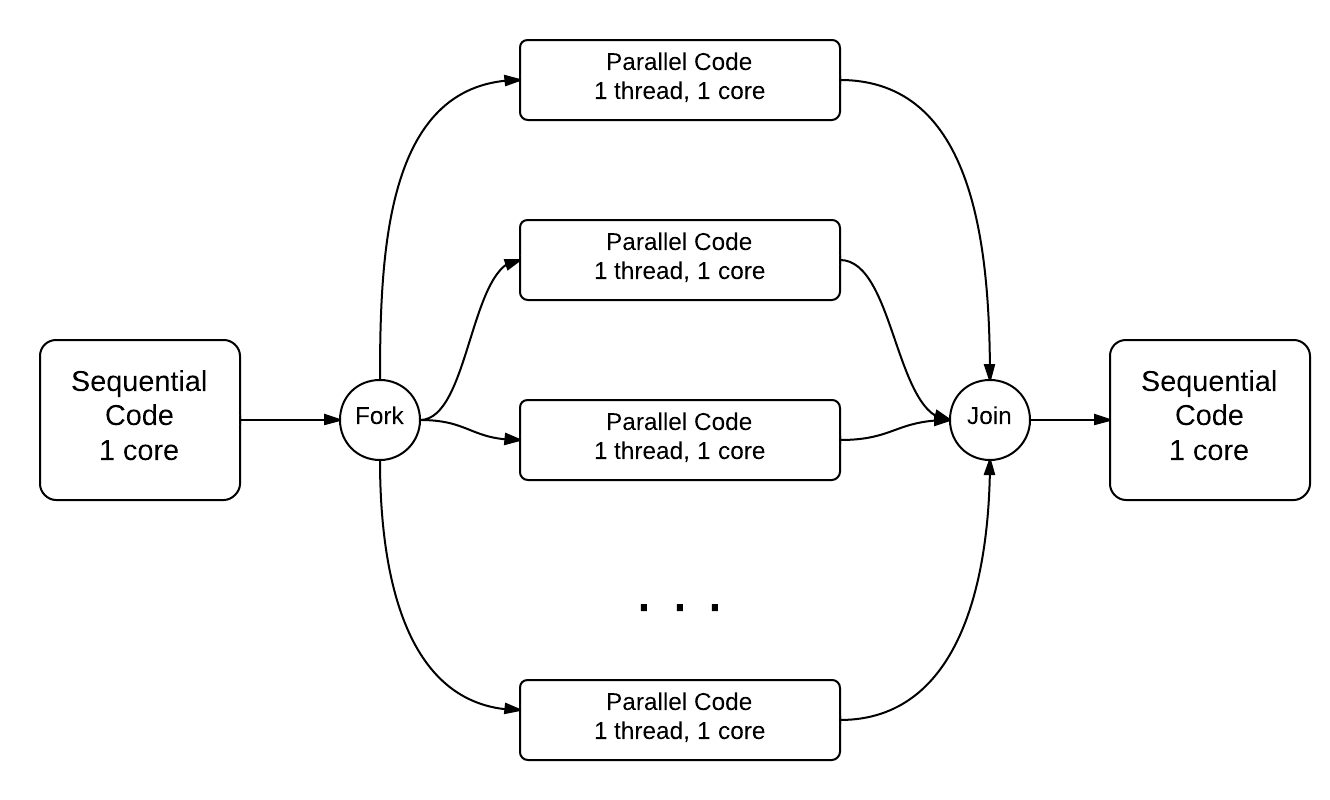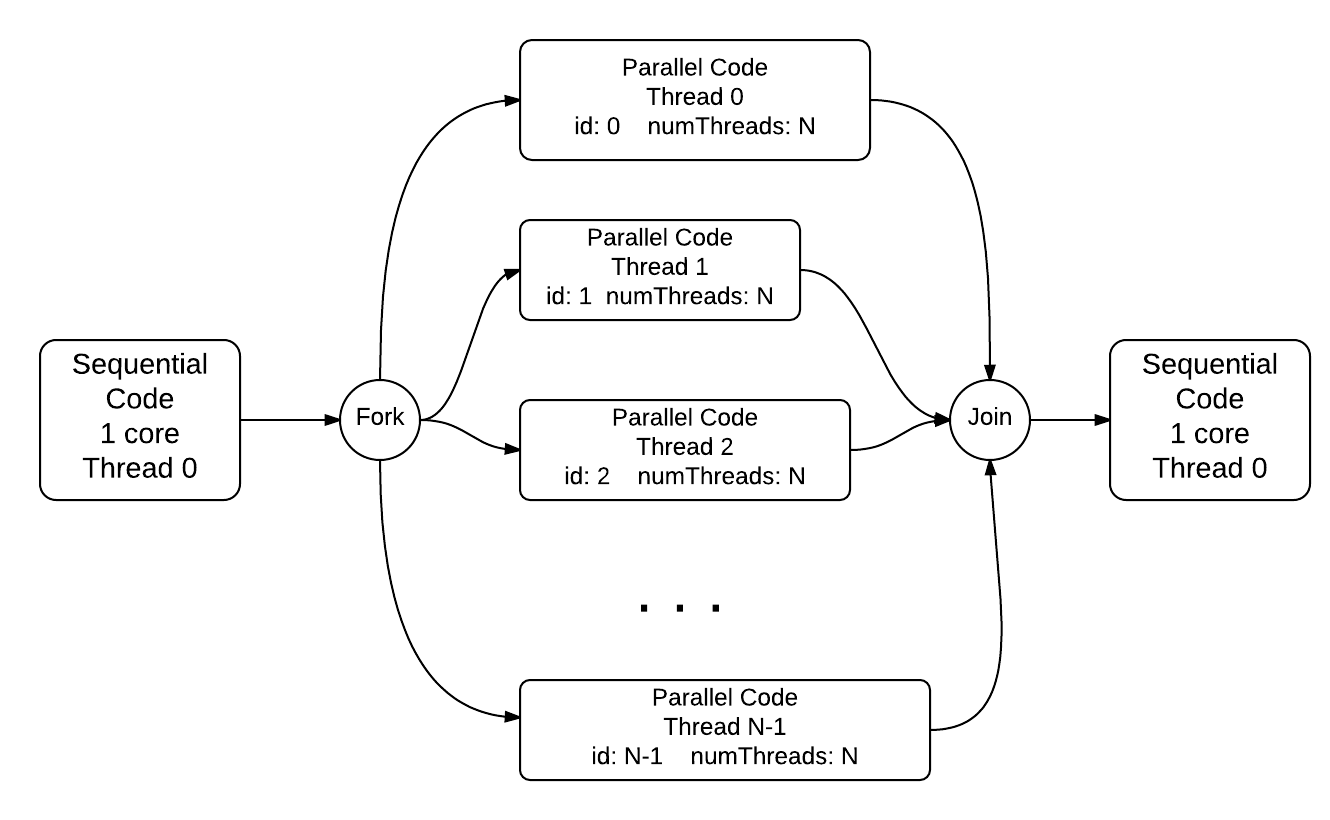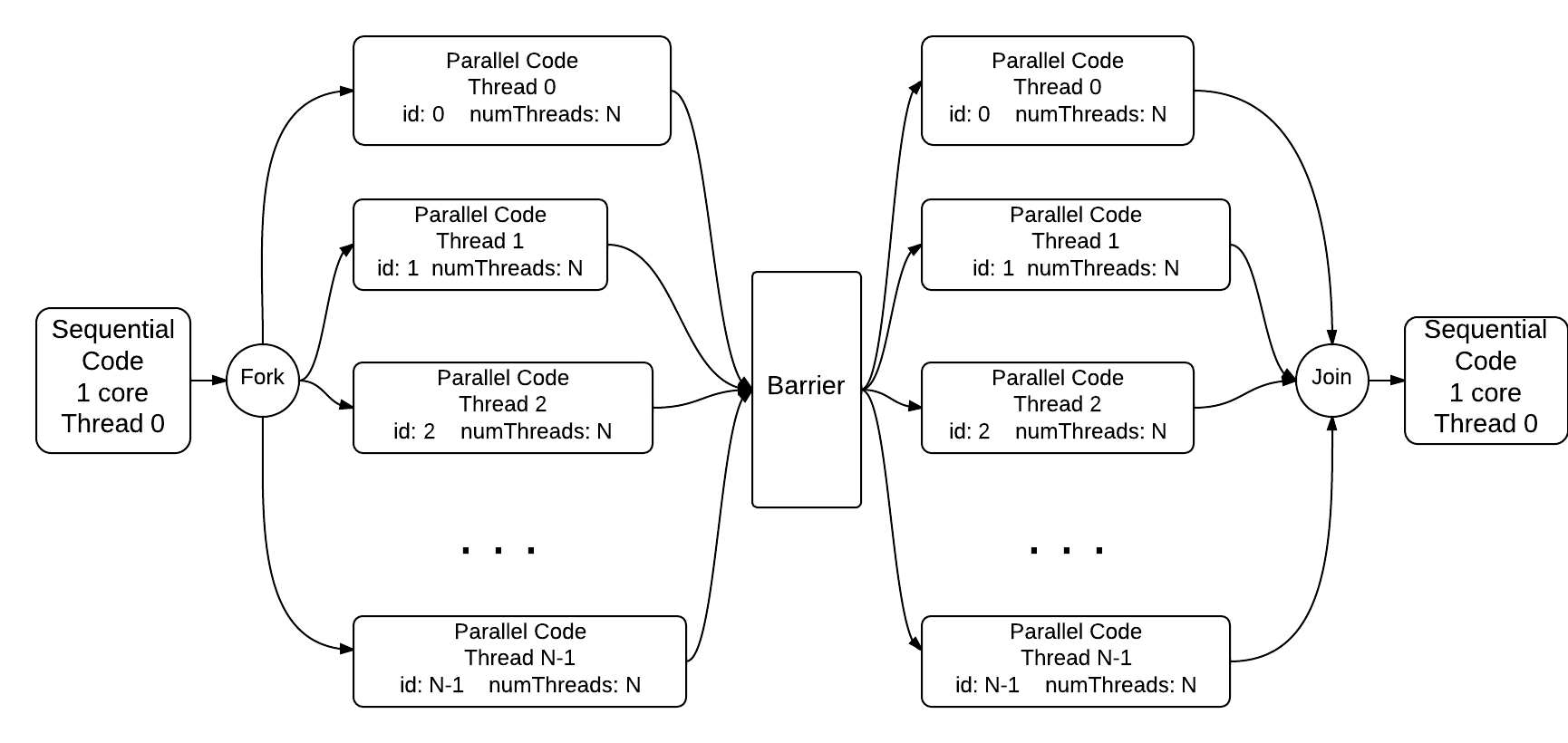Shared Memory Program Structure and Coordination Patterns¶
0. Program Structure Implementation Strategy: The basic fork-join pattern¶
file: openMP/00.forkJoin/forkJoin.c
Build inside 00.forkJoin directory:
make forkjoin
Execute on the command line inside 00.forkJoin directory:
./forkjoin
The omp parallel pragma on line 21, when uncommented, tells the compiler to fork a set of threads to execute the next line of code (later you will see how this is done for a block of code). You can conceptualize how this works using the following diagram, where time is moving from left to right:

Observe what happens on the machine where you are running this code, both when you have the pragma commented (no fork) and when you uncomment it (adding a fork).
Note that in OpenMP the join is implicit and does not require a pragma directive.
1 2 3 4 5 6 7 8 9 10 11 12 13 14 15 16 17 18 19 20 21 22 23 24 25 26 27 28 | /* forkJoin.c
* ... illustrates the fork-join pattern
* using OpenMP's parallel directive.
*
* Joel Adams, Calvin College, November 2009.
*
* Usage: ./forkJoin
*
* Exercise:
* - Compile & run, uncomment the pragma,
* recompile & run, compare results.
*/
#include <stdio.h> // printf()
#include <omp.h> // OpenMP
int main(int argc, char** argv) {
printf("\nBefore...\n");
// #pragma omp parallel
printf("\nDuring...");
printf("\n\nAfter...\n\n");
return 0;
}
|
1. Program Structure Implementation Strategy: Fork-join with setting the number of threads¶
file openMP/01.forkJoin2/forkJoin2.c
Build inside 01.forkJoin2 directory:
make forkjoin2
Execute on the command line inside 01.forkJoin2 directory:
./forkjoin2
This code illustrates that one program can fork and join more than once and that programmers can set the number of threads to use in the parallel forked code.
Note on line 28 there is an OpenMP function called omp_set_num_threads for setting the number of threads to use for each fork, which occur when the omp_parallel pragma is used. Also note on line 35 that you can set the number of threads for the very next fork indicated by an omp_parallel pragma by augmenting the pragma as shown in line 35. Follow the instructions in the header of the code file to understand the difference between these.
1 2 3 4 5 6 7 8 9 10 11 12 13 14 15 16 17 18 19 20 21 22 23 24 25 26 27 28 29 30 31 32 33 34 35 36 37 38 39 40 41 42 43 44 45 46 47 | /* forkJoin2.c
* ... illustrates the fork-join pattern
* using multiple OpenMP parallel directives,
* and changing the number of threads two ways.
*
* Joel Adams, Calvin College, May 2013.
*
* Usage: ./forkJoin2
*
* Exercise:
* - Compile & run, compare results to source.
* - Predict how many threads will be used in 'Part IV'?
* - Uncomment 'Part IV', recompile, rerun.
*/
#include <stdio.h> // printf()
#include <omp.h> // OpenMP
int main(int argc, char** argv) {
printf("\nBeginning\n");
#pragma omp parallel
printf("\nPart I");
printf("\n\nBetween I and II...\n");
omp_set_num_threads(3);
#pragma omp parallel
printf("\nPart II...");
printf("\n\nBetween II and III...\n");
#pragma omp parallel num_threads(5)
printf("\nPart III...");
/*
printf("\n\nBetween III and IV...\n");
#pragma omp parallel
printf("\nPart IV...");
*/
printf("\n\nEnd\n\n");
return 0;
}
|
2. Program Structure Implementation Strategy: Single Program, multiple data¶
file: openMP/02.spmd/spmd.c
Build inside 02.spmd directory:
make spmd
Execute on the command line inside 02.spmd directory:
./spmd
Note how there are OpenMP functions to obtain a thread number and the total number of threads. We have one program, but multiple threads executing in the forked section, each with a copy of the id and num_threads variables. Programmers write one program, but write it in such a way that each thread has its own data values for particular variables. This is why this is called the single program, multiple data (SPMD) pattern.
Most parallel programs use this SPMD pattern, because writing one program is ultimately the most efficient method for programmers. It does require you as a programmer to understand how this works, however. Think carefully about how each thread executing in parallel has its own set of variables. Conceptually, it looks like this, where each thread has its own memory for the variables id and numThreads:

When the pragma is uncommented in the code below, note what the default number of threads is. Here the threads are forked and execute the block of code inside the curly braces on lines 22 through 26. This is how we can have a block of code executed concurrently on each thread.
When you execute the parallel version containing the pragma (uncommenting line 20), what do you observe about the order of the printed lines? Run the program multiple times– does the ordering change? This illustrates an important point about threaded programs: the ordering of execution of statements between threads is not guaranteed. This is also illustrated in the diagram above.
1 2 3 4 5 6 7 8 9 10 11 12 13 14 15 16 17 18 19 20 21 22 23 24 25 26 27 28 29 30 | /* spmd.c
* ... illustrates the single-program-multiple-data (SPMD)
* pattern using two basic OpenMP commands...
*
* Joel Adams, Calvin College, November 2009.
*
* Usage: ./spmd
*
* Exercise:
* - Compile & run
* - Uncomment pragma, recompile & run, compare results
*/
#include <stdio.h>
#include <omp.h>
int main(int argc, char** argv) {
printf("\n");
// #pragma omp parallel
{
int id = omp_get_thread_num();
int numThreads = omp_get_num_threads();
printf("Hello from thread %d of %d\n", id, numThreads);
}
printf("\n");
return 0;
}
|
3. Program Structure Implementation Strategy: Single Program, multiple data with user-defined number of threads¶
file: openMP/03.spmd2/spmd2.c
Build inside 03.spmd2 directory:
make spmd2
Execute on the command line inside 03.spmd2 directory:
./spmd2 4
Replace 4 with other values for the number of threads
Here we enter the number of threads to use on the command line. This is a useful way to make your code versatile so that you can use as many threads as you would like.
1 2 3 4 5 6 7 8 9 10 11 12 13 14 15 16 17 18 19 20 21 22 23 24 25 26 27 28 29 30 31 32 33 34 35 36 37 38 39 40 | /* spmd2.c
* ... illustrates the SPMD pattern in OpenMP,
* using the commandline arguments
* to control the number of threads.
*
* Joel Adams, Calvin College, November 2009.
*
* Usage: ./spmd2 [numThreads]
*
* Exercise:
* - Compile & run with no commandline args
* - Rerun with different commandline args,
* until you see a problem with thread ids
* - Fix the race condition
* (if necessary, compare to 02.spmd)
*/
#include <stdio.h>
#include <omp.h>
#include <stdlib.h>
int main(int argc, char** argv) {
int id, numThreads;
printf("\n");
if (argc > 1) {
omp_set_num_threads( atoi(argv[1]) );
}
#pragma omp parallel
{
id = omp_get_thread_num();
numThreads = omp_get_num_threads();
printf("Hello from thread %d of %d\n", id, numThreads);
}
printf("\n");
return 0;
}
|
4. Coordination: Synchronization with a Barrier¶
file: openMP/04.barrier/barrier.c
Build inside 04.barrier directory:
make barrier
Execute on the command line inside 04.barrier directory:
./barrier 4
Replace 4 with other values for the number of threads
The barrier pattern is used in parallel programs to ensure that all threads complete a parallel section of code before execution continues. This can be necessary when threads are generating computed data (in an array, for example) that needs to be completed for use in another computation.
Conceptually, the running code is excuting like this:

Note what happens with and without the commented pragma on line 31.
1 2 3 4 5 6 7 8 9 10 11 12 13 14 15 16 17 18 19 20 21 22 23 24 25 26 27 28 29 30 31 32 33 34 35 36 37 38 39 | /* barrier.c
* ... illustrates the use of the OpenMP barrier command,
* using the commandline to control the number of threads...
*
* Joel Adams, Calvin College, May 2013.
*
* Usage: ./barrier [numThreads]
*
* Exercise:
* - Compile & run several times, noting interleaving of outputs.
* - Uncomment the barrier directive, recompile, rerun,
* and note the change in the outputs.
*/
#include <stdio.h>
#include <omp.h>
#include <stdlib.h>
int main(int argc, char** argv) {
printf("\n");
if (argc > 1) {
omp_set_num_threads( atoi(argv[1]) );
}
#pragma omp parallel
{
int id = omp_get_thread_num();
int numThreads = omp_get_num_threads();
printf("Thread %d of %d is BEFORE the barrier.\n", id, numThreads);
// #pragma omp barrier
printf("Thread %d of %d is AFTER the barrier.\n", id, numThreads);
}
printf("\n");
return 0;
}
|
5. Program Structure: The Master-Worker Implementation Strategy¶
file: openMP/05.masterWorker/masterWorker.c
Build inside 05.masterWorker directory:
make masterWorker
Execute on the command line inside 05.masterWorker directory:
./masterWorker 4
Replace 4 with other values for the number of threads
Once you have mastered the notion of fork-join and single-program, multiple data, the next common pattern that programmers use in association with these patterns is to have one thread, called the master, execute one block of code when it forks while the rest of the threads, called workers, execute a different block of code when they fork. This is illustrated in this simple example (useful code would be more complicated).
1 2 3 4 5 6 7 8 9 10 11 12 13 14 15 16 17 18 19 20 21 22 23 24 25 26 27 28 29 30 31 32 33 34 35 36 37 38 39 40 41 42 | /* masterWorker.c
* ... illustrates the master-worker pattern in OpenMP
*
* Joel Adams, Calvin College, November 2009.
*
* Usage: ./masterWorker
*
* Exercise:
* - Compile and run as is.
* - Uncomment #pragma directive, re-compile and re-run
* - Compare and trace the different executions.
*/
#include <stdio.h> // printf()
#include <stdlib.h> // atoi()
#include <omp.h> // OpenMP
int main(int argc, char** argv) {
printf("\n");
if (argc > 1) {
omp_set_num_threads( atoi(argv[1]) );
}
// #pragma omp parallel
{
int id = omp_get_thread_num();
int numThreads = omp_get_num_threads();
if ( id == 0 ) { // thread with ID 0 is master
printf("Greetings from the master, # %d of %d threads\n",
id, numThreads);
} else { // threads with IDs > 0 are workers
printf("Greetings from a worker, # %d of %d threads\n",
id, numThreads);
}
}
printf("\n");
return 0;
}
|
